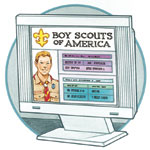
News Briefs
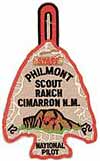
Apply now for summer staff positions at BSA national high adventure bases
This summer the BSA will hire about 950 people to work at Philmont Scout Ranch, 160 at the Florida Sea Base, and 120 at the Northern Tier bases. Jobs range from crew guide to mountain bike instructor to food server.
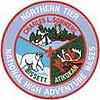
Applicants must be physically fit, age 18 (by June 1) or older, and available to work from May 30 to Aug. 21 (through Aug. 31 for the Florida Sea Base). Starting salary is based on experience and ranges upward from $790 per month. Room and three meals a day are included.
Contact each base for an application and information:
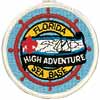
• Philmont Scout Ranch, RR1, Box 35, Cimarron, NM 87714, (505) 376-2281, philstaff@philmontscoutranch.org.
• Northern Tier National High Adventure Bases, P.O. Box 509, Ely, MN 55731-0509, (218) 365-4811, info@ntier.org.
• Florida National High Adventure Sea Base, P.O. Drawer 1906, Islamorada, FL 33036, (305) 664-4173, www.bsaseabase.org.
Fourth Edition of the Fieldbook

The newly published fourth edition of the BSA Fieldbook (BSA No. 33104) is a comprehensive resource for older Boy Scouts, Venturers, unit leaders, trainers, and other outdoor enthusiasts, a compendium of intermediate and advanced outdoor skills.
Along with insightful and inspiring quotations from well-known outdoorsmen, the book includes sections on leadership and trek preparation, leaving no trace, trek adventures, and appreciating the environment.
The book's 34 chapters cover a range of outdoor skills and topics, such as backcountry hygiene and waste disposal, navigation, and weather monitoring, plus such high adventure possibilities as caving, sailing, and ski touring.
The new Fieldbook also focuses on safety in the outdoors, with chapters on search and rescue, extreme-weather traveling and camping, and watercraft adventure safety. Readers are reminded that exploring the outdoors comes with the responsibility to be a good steward of its resources.
The book features more than 500 color photographs of the great outdoors and more than 200 informative graphics.
In addition, there is a companion Web site offering additional references and Internet resources at www.bsafieldbook.org.
The new Fieldbook will be available in Scout shops for $19.95. Special hardbound, spiral-bound, and faux-leather Collector's edition Fieldbooks are also planned.
2004 National Endowment Art Tour to visit nine cities
Displays of BSA artwork by Norman Rockwell, Joseph Csatari, and others will be the featured attractions during the nine stops scheduled for the 2004 National Endowment Art Tour.
This year's art tour theme, "Scouting's Classics," will be represented by many of the most revered Rockwell and Csatari paintings, along with selected artwork from five other well-known artists.
The tour is designed to honor local individuals for substantial contributions to their local Scout council endowment fund and to serve as a catalyst for additional giving. At each location, the BSA will host an informational seminar for prospective donors and a reception, which will include an induction ceremony for new 1910 Society and Founders Circle members.
Future locations and dates for the 2004 tour are March 4, El Paso, Tex.; March 11, Amarillo, Tex.; April 1, Columbus, Ga.; April 15, Jacksonville, Fla.; April 29, Cincinnati, Ohio; May 13, Highland Park, Ill.; May 27, Des Moines, Iowa; and June 3, Pocatello, Idaho.
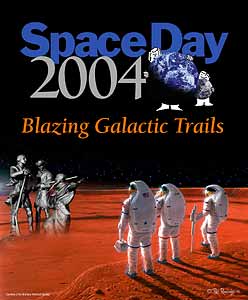
Space Day 2004 Provides Opportunities For Scouting Programs and Activities
Space Day, May 6, 2004, is an annual, global educational initiative to spark youth interest in science, math, engineering, and technology through the wonders of space. This year's theme, Blazing Galactic Trails, focuses on the challenges of space exploration during the bicentennial of the Lewis and Clark Expedition.
Packs and troops will find ideas for unit activities at the official Web site, www.spaceday.org. Local events can be found in the "Space Day in Your Neighborhood" section.
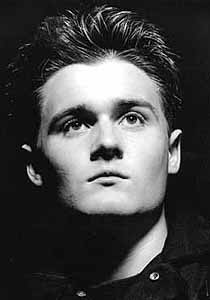 Eagle Scout candidate and robotics enthusiast Justin Houchin is an official teen spokesperson for Space Day 2004. Photograph Courtesy Of Space Day 2004 |
The Web site also provides information on programs such as Design Challenges, a team competition for solving space exploration design challenges, and on Cyber Space Day, the May 6 interactive Web event in which teachers, students, and space enthusiasts throughout the world participate.
Eagle Scout candidate and robotics enthusiast Justin Houchin, 17, is one of several official youth spokespersons for Space Day 2004. In this role, he promotes science and technology with elementary students. "I hope to help spark kids' imaginations about space exploration and the exciting career opportunities if they follow their dreams," said Justin, who is a member of Troop 8 in Hollywood, Calif.
NUMBERS
7— annual merit badge camp-outs hosted by the Roanoke, Va., Moose Lodge No. 284 for Scouts from three districts in the Blue Ridge Mountains Council. Scouts can select one of a dozen merit badges to complete during the weekend, which is free and includes all meals from Saturday through Sunday breakfast. At the 2003 event last September, 126 Scouts from 21 troops earned 118 merit badges, with the most popular being Pottery, Citizenship in the Community, and Fire Safety.
76— tons of food collected by Scouts, leaders, and family members participating in the 2003 Scouting for Food Good Turn in the Miami Valley Council (Dayton, Ohio), topping the 2002 total by 8.5 tons. An additional 22 tons of food collected by Scouts in the neighboring Tecumseh Council (Springfield, Ohio) resulted in a total of 98 tons of food provided to area food banks in the southwestern Ohio area served by the two councils.
330— Scouts from four states and six councils who earned the Railroading merit badge during the Mississippi Valley Council's Railroad Camporee in Burlington, Iowa, in April 2003. In addition, 178 Cub Scouts passed requirements for a special camporee patch. Co-hosted by the council and the Chicagoland Lionel Railroad Club, the event included merit badge sessions taught by more than 100 adult volunteers, plus a schedule that allowed Scouts to operate model trains, tour the Burlington Northern Santa Fe Railway locomotive shops, ride regional transit authority buses, view a spectacular fireworks show, and more.
1,228— Scouts and adult leaders from 104 units who participated in the Greater Cleveland Council's first annual Yard Charge Community Clean Up Day. The council worked with the office of Cleveland Mayor Jane L. Campbell to develop the one-day leaf-raking project, and Mayor Campbell attended the early morning kickoff ceremony last Nov. 8. Scouts and Scouters then removed an estimated 4,000 biodegradable bags of leaves from the lawns of 415 homes, selected because of the frailty of their elderly occupants.
11,000— and more— Scouts and family members who attended the Mid-America Council's quadrennial Jubilee councilwide camporee in October at Mahoney State Park near Omaha, Neb. With the theme "Freedom Fest," the three-day event featured entertainment from Grammy-winning singer Lee Greenwood. Events included a construction fair, providing Scouts hands-on activities as demonstrated by labor unions; bike stunt shows; opportunities to earn several merit badges; radio-controlled model aviation; Native American games; a labyrinth; monkey bridges; and much more.
Land Agencies Help With Eagle Projects
By Earle Kirkbride
Government agencies such as the Forest Service, Bureau of Land Management, and National Park Service can provide opportunities for Eagle Scout service projects. An example is the Pine Valley Ranger District of the Dixie National Forest, near St. George, Utah.
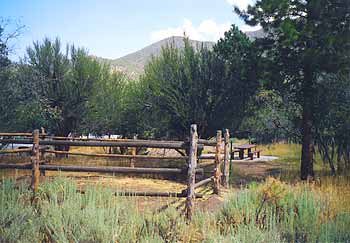 Horse corrals have been constructed as Eagle Scout projects in the equestrian campground of the Pine Valley Ranger District in the Dixie National Forest. Photograph Courtesy Of Pine Valley Ranger District, Dixie National Forest |
"Everyone wins with an Eagle project—the public, the forest, and the Scout," says Bevan Killpack, Pine Valley district ranger. "Fred Ybright, our agency representative, has helped Scouts plan and complete a number of projects that are useful to the forest and will benefit the public for years, as well as help the Scout achieve his goal of becoming an Eagle. We are very proud of projects Scouts have planned and completed."
Projects developed by Scouts with Ybright's assistance include rebuilding and marking trails, building individual horse corrals at an equestrian campground, building and installing picnic tables, building and rebuilding campsites, building a pedestrian and horse bridge in the Pine Valley Wilderness, building benches at a campfire site, and, with a tree core sample, preparing an exhibit connecting tree rings with historical dates.
"I've got more ideas for future projects for the next young men looking for a project to help earn that Eagle rank," Ybright says.
The impact of one Eagle project can be seen at Pine Valley's equestrian campground, where Scouts and backcountry horsemen helped build 11 corrals for campers to keep their horses near their campsites.
To find an Eagle project, look to nearby federal land agencies. Agency representatives like Fred Ybright will help develop projects beneficial to the agency, the public, and the Scout.
Freelance writer Earle Kirkbride has served as a summer volunteer with the Forest Service.
Scout's Improved Shoe-Checking Device Is a Boon for Air Travelers
By Leah Ingram
The inspiration for an Eagle Scout service project arrived in a phone call early last year for Josh Pfluger, now 16, of Rockford, Ill. A neighbor, Rick Spencer, who works for the Transportation Security Administration (TSA), called to see if Josh's parents, Dan and Dawn, knew of a candidate for Eagle Scout looking for a good service project idea.
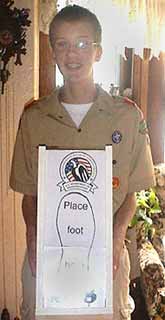 Josh Pfluger Photograph Courtesy Of Rick Spencer |
Spencer had recently created a prototype of a shoe-checking metal detector for the TSA and successfully tested the device, shaped like a triangular shoeshine box, at the airport in nearby Madison, Wis. "If shoes don't have metal in them, a passenger doesn't have to take the extra time to take them off to be x-rayed," Spencer explained.
Officials at Chicago's O'Hare International Airport wanted 15 of the devices, but Spencer, a TSA scheduling operations officer, was too busy to fill the order. Figuring that assembling shoe metal detectors that could make the lives of airline passengers easier would be a good Eagle Scout project, he decided to look for a Scout interested in the opportunity.
Spencer knew the Pflugers were active in Scouting. "They said, 'Well, Josh is looking for a project,'" he recalled, "and I said, 'Send him over.'"
Josh was intrigued by Spencer's design, which included a handheld metal detector. In March 2003, he and seven fellow Scouts from Rockford's Troop 37 began working on the project. Josh even improved Spencer's design a bit, by adding a slide-off Plexiglas cover to facilitate wand replacement. (The original design required taking the device apart to replace a wand.)
By April, Josh and friends had completed all 15 shoe metal detectors and delivered them to O'Hare.
Josh didn't think the project was particularly newsworthy until July 24, 2003, when The Wall Street Journal ran a story called "Do-It-Yourself Airport Security." It mentioned that the devices in O'Hare were "built by Boy Scout Troop 37 of Rockford, Ill." That same day the "Good Morning America" network TV show called and booked Josh and his mother on a flight to New York City, where they appeared on the show the next day.
"It was awesome," says Josh, who later appeared on CNN, Fox News, and WGN in Chicago, sometimes doing live interviews from his garage, where he assembled the devices.
And it all began with just a simple phone call from a neighbor across the street.
European Camp Staff Program seeks BSA Scouters
Scouters age 18 to 30 can learn about Scouting in Europe and develop leadership skills by working as a volunteer staff member at a Scout camp. Applicants must be BSA members and able to work for a minimum of six weeks.
Information and applications are available from the BSA International Division. Applications must be approved by the local Scout council and the International Division before being forwarded for final selection to individual host centers.
Placed applicants pay their own travel to and from the Scout center, after which the European Scout Region will refund a portion of an individual's travel costs.
Application deadline is March 15. Contact BSA International Division, S221, 1325 W. Walnut Hill Ln., P.O. Box 152079, Irving, TX 75015-2079; phone (972) 580-2403; fax (972) 580-2413; e-mail escoggin@netbsa.org.
Cub Scouts Explore Local Historical Trails
By Olivia Ogren-Hrejsa
For 14 years the Cub Scout Family Historic Trail Hike has allowed local Cub Scouts and family members to explore one of five historic trails in Irving, Tex.
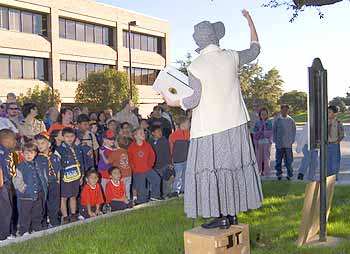 Dressed in 19th-century frontier clothing, district activities chairman Pam Peveto explains to Cub Scouts how the BSA national office and National Scouting Museum are located on the site of one of several historical trails. Photograph By Olivia Ogren-Hrejsa |
With the assistance of Dallas Area Rapid Transit (DART), more than 1,000 hikers, from Cub Scouts to grandparents, travel by bus and on foot along old trade routes and wagon trails, exploring different historic areas. Hikers earn a different trail patch each year and eventually can complete a full Texas Trails Patch.
The 2003 hike in October featured a new attraction—a visit to the BSA's National Scouting Museum.
Cub Scouts and their families rode buses from the DART station to the BSA national office, next to the National Scouting Museum. A marker in front of the national office informed visitors that this is the site of the trail to Bird's Fort, which was located just north of present-day Arlington, Tex.
Pam Peveto, activities chairman in the Western Star District of the Dallas-based Circle Ten Council, explained the significance of the fort, built in 1841 to protect what was then the northwest corner of the frontier in the Republic of Texas. Pack families then walked to the museum next door for a look at another type of history—nearly a century of Scouting.
Jim Dunkley, chairman of the Irving Heritage Society's Historic Trails Committee and a Scout leader, created the hiking program to introduce Scouts and families of the Western Star District to the area's history.
"The trail goes [by the national office and museum], so the National Scouting Museum becomes part of this particular hike, and that makes it extra-special," Peveto said.
Ron Flores, the program's coordinator and a Scoutmaster, agreed the museum added to this year's hike.
"This is one of the few events to allow many different family members to easily participate," he said. "It is a great opportunity for [pack] families to get together."
The program's convenience is enhanced by the cooperative efforts of the Irving Historical Society and DART. In addition to providing free transportation, DART teamed with the historical society to create historical trail maps to guide the hikers.
On the bookshelf
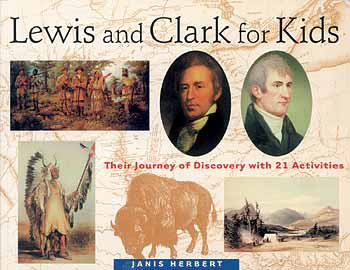
The article on pages 22 to 26 in this issue describes five wilderness locations where it's possible to retrace the footsteps of the Lewis and Clark "journey of discovery" (1803 to 1806). Those who can't visit the selected locations can still participate in the expedition's national bicentennial (through 2006) with 21 activities in Lewis and Clark for Kids ($14.95, www.chicagoreviewpress.com, Chicago Review Press). The book traces the trip in detail and provides instructions for projects like making moccasins, beeswax candles, "fruit leather," and more.
Extensive Lewis and Clark facts and descriptions are also found in the easy-to-use Lewis & Clark for Dummies ($19.99, www.dummies.com, Wiley). In addition to insightful details about each leg of the journey, the book lists places to visit on the Lewis and Clark National Historic Trail and commemorative events through 2006, and shows how and where to find more information.
The year 2003 also marked the 100th anniversary of another history-shaking event, the first successful powered flight of a man-carrying, heavier-than-air craft at Kitty Hawk, N.C., in December 1903. In The Wright Brothers for Kids ($14.95, Chicago Review Press "For Kids" series), young readers can experience this moment in time through 21 activities, from making kites, paper gliders, and a rubber-band-powered flier to building a battery-powered telegraph device.
March - April 2004 Table of Contents
Copyright © 2004 by the Boy Scouts of America. All rights thereunder reserved; anything appearing in Scouting magazine or on its Web site may not be reprinted either wholly or in part without written permission. Because of freedom given authors, opinions may not reflect official concurrence.